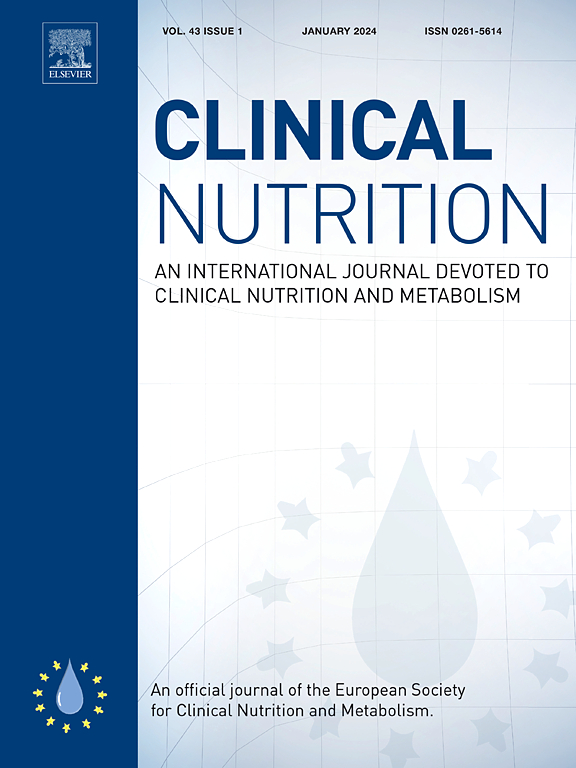The effects of Mediterranean diet with and without exercise on body composition in adults with chronic disease: A systematic review and meta-analysis of clinical trials
IF 7.4
2区 医学
Q1 NUTRITION & DIETETICS
引用次数: 0
Abstract
Background & aims
The Mediterranean diet (MedDiet), with and without energy restriction, has been associated with reduced risk of numerous chronic diseases, including type 2 diabetes and cardiovascular disease. Exercise is well known to improve various health outcomes in individuals with chronic diseases and emerging evidence indicates that combining diet and exercise may be superior to individual interventions. The primary aim of this systematic review and meta-analysis was to assess the effects of all MedDiet interventions (regardless of exercise or energy restriction), as well as MedDiet alone (and in hypocaloric and isocaloric subgroups) on body composition outcomes [weight, waist circumference (WC), body mass index (BMI), body fat (BF), lean mass (LM) and visceral adipose tissue (VAT)] in adults with chronic disease. Secondary aims were to assess the effects of MedDiet plus exercise, including in hypocaloric and isocaloric subgroups, on body composition outcomes.
Methods
Four electronic databases (ProQuest, Medline, Embase and CINAHL) were searched from inception to January 2025. Randomised controlled trials including MedDiet interventions in adults with chronic diseases that assessed body composition as outcomes were included. Outcomes were pooled using random-effect meta-analysis for MedDiet interventions compared with controls to determine the standardised mean difference.
Results
Twenty papers were included in the systematic review and meta-analysis, reporting data from 17 unique studies. Reductions in BMI (SMD = −1.21, P = 0.01) and VAT (SMD = −0.12, P = 0.02) and improvements in LM (SMD = 0.11, P = 0.01) were found in meta-analytic models including all MedDiet interventions (regardless of exercise or energy restriction). MedDiet alone did not result in significant changes in any body composition outcomes. Interventions combining MedDiet plus exercise had statistically significant effects on reducing weight (SMD = −0.19), BMI (SMD = −0.27), WC (SMD = −0.39), BF (SMD = −0.13) and VAT (SMD = −0.12), with all P < 0.05. Although effect sizes were small, the estimated absolute reductions were approximately 2.5 kg in weight, 1.0 kg/m2 in BMI, 3.5 cm in WC and 102 g in VAT, based on SD reported previously in the literature. Subgroup analysis showed that hypocaloric MedDiet plus exercise significantly reduced BMI (SMD = −0.24, P = 0.01), BF (SMD = −0.13, P = 0.01), and VAT (SMD = −0.12, P = 0.02), while isocaloric MedDiet with exercise led to significant reductions in weight (SMD = −0.18, P = 0.04), BMI (SMD = −0.24, P = 0.02), and WC (SMD = −0.32, P = 0.0) relative to controls.
Conclusion
MedDiet interventions (regardless of exercise or energy restriction) led to improvements in BMI, LM and VAT. MedDiet in combination with exercise, with or without energy restriction improved all body composition outcomes, with the exception of LM. These novel findings highlight the potential importance of a multimodal intervention, integrating the MedDiet with exercise for chronic disease management.
This systematic review and meta-analysis has been registered with PROSPERO (CRD42022358345).
有运动和没有运动的地中海饮食对成人慢性病患者身体成分的影响:临床试验的系统回顾和荟萃分析
背景,地中海饮食(MedDiet),无论是否有能量限制,都与许多慢性疾病的风险降低有关,包括2型糖尿病和心血管疾病。众所周知,运动可以改善慢性病患者的各种健康状况,新出现的证据表明,饮食和运动相结合可能优于个人干预。本系统综述和荟萃分析的主要目的是评估所有MedDiet干预(不考虑运动或能量限制)以及单独使用MedDiet(以及低热量和等热量亚组)对慢性疾病成人身体组成结局[体重、腰围(WC)、体重指数(BMI)、体脂(BF)、瘦质量(LM)和内脏脂肪组织(VAT)]的影响。次要目的是评估MedDiet加运动(包括低热量和等热量亚组)对身体成分结果的影响。方法检索自建库至2025年1月的ProQuest、Medline、Embase和CINAHL 4个电子数据库。纳入了随机对照试验,包括MedDiet干预成人慢性疾病,评估身体成分作为结果。使用随机效应荟萃分析将MedDiet干预与对照组的结果进行汇总,以确定标准化平均差异。结果系统评价和荟萃分析共纳入20篇论文,报告了17项独特研究的数据。在meta分析模型中发现,包括所有MedDiet干预(无论运动或能量限制)在内的BMI (SMD = - 1.21, P = 0.01)和VAT (SMD = - 0.12, P = 0.02)降低,LM (SMD = 0.11, P = 0.01)改善。单独的MedDiet并没有导致任何身体成分结果的显著变化。结合MedDiet和运动的干预措施在减轻体重(SMD = - 0.19)、BMI (SMD = - 0.27)、WC (SMD = - 0.39)、BF (SMD = - 0.13)和VAT (SMD = - 0.12)方面具有统计学意义,P <;0.05. 虽然效应量很小,但根据先前文献报道的SD,估计绝对减少的体重约为2.5 kg, BMI为1.0 kg/m2, WC为3.5 cm, VAT为102 g。亚组分析显示,低热量MedDiet加运动显著降低BMI (SMD = - 0.24, P = 0.01)、BF (SMD = - 0.13, P = 0.01)和VAT (SMD = - 0.12, P = 0.02),而等热量MedDiet加运动相对于对照组显著降低体重(SMD = - 0.18, P = 0.04)、BMI (SMD = - 0.24, P = 0.02)和WC (SMD = - 0.32, P = 0.0)。结论meddiet干预(不考虑运动或能量限制)可改善BMI、LM和VAT。MedDiet与运动相结合,有或没有能量限制,改善了所有身体成分的结果,LM除外。这些新发现强调了多模式干预的潜在重要性,将MedDiet与运动结合起来用于慢性疾病管理。该系统评价和荟萃分析已在PROSPERO注册(CRD42022358345)。
本文章由计算机程序翻译,如有差异,请以英文原文为准。
求助全文
约1分钟内获得全文
求助全文
来源期刊

Clinical nutrition
医学-营养学
CiteScore
14.10
自引率
6.30%
发文量
356
审稿时长
28 days
期刊介绍:
Clinical Nutrition, the official journal of ESPEN, The European Society for Clinical Nutrition and Metabolism, is an international journal providing essential scientific information on nutritional and metabolic care and the relationship between nutrition and disease both in the setting of basic science and clinical practice. Published bi-monthly, each issue combines original articles and reviews providing an invaluable reference for any specialist concerned with these fields.
 求助内容:
求助内容: 应助结果提醒方式:
应助结果提醒方式:


